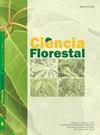Analysis of genetic diversity in two plantations of Pinus caribaea var. hondurensis
IF 0.5
4区 农林科学
Q4 FORESTRY
引用次数: 0
Abstract
Forest tree breeding activities in plantations with exotic species implies several instances of material selection where genetic variation can be affected. The objective of the work was to verify the genetic variability present in two plantations of Pinus caribaea var. hondurensis by microsatellite markers, initially designed for Pinus taeda fluorescent-labeled. Thus, 299 individuals were analyzed using eight polymorphic microsatellite markers. The results indicate that both plantations have adequate levels of genetic diversity that are representative of the Pinus genus. Through the Bayesian method, it was possible to detect two different population genetic structures (K = 2) between both plantations analyzed. In conclusion, this study suggests that microsatellites markers are useful tools to monitor genetic variation in genetic breeding programs. The genetic diversity estimated in both plantations is similar and typical for Pinus plantations, and as expected, there was a slight decrease in genetic variability in the commercial plantation in comparation with the base plantation.两种美洲松人工林遗传多样性分析
外来物种种植园中的林木育种活动意味着遗传变异可能受到影响的几种材料选择。本工作的目的是通过最初为火炬松荧光标记设计的微卫星标记来验证两个加勒比松人工林中存在的遗传变异性。因此,使用8个多态性微卫星标记对299个个体进行了分析。结果表明,两个人工林都具有足够的遗传多样性水平,是松属的代表。通过贝叶斯方法,可以在分析的两个人工林之间检测到两种不同的群体遗传结构(K=2)。总之,这项研究表明,微卫星标记是监测遗传育种计划中遗传变异的有用工具。两个人工林中估计的遗传多样性相似,是典型的松人工林,正如预期的那样,与基本人工林相比,商业人工林的遗传变异略有下降。
本文章由计算机程序翻译,如有差异,请以英文原文为准。
求助全文
约1分钟内获得全文
求助全文
来源期刊

Ciencia Florestal
农林科学-林学
CiteScore
0.80
自引率
0.00%
发文量
85
审稿时长
18-36 weeks
期刊介绍:
The journal Forest Science was established in 1991 with the goal of being a vehicle for dissemination which are published works tércnico-scientific forest-related, the following bodies crowded the Centro de Ciências Rurais of Universidade Federal de Santa Maria:
- Centro de Pesquisas Florestais - CEPEF
- Programa de Pós-graduação em Engenharia Florestal - PPGEF
- Departamento de Ciências Florestais - DCFL
MISSION:
Publish scientific papers, technical notes, and literature reviews related to the area of forest sciences.
 求助内容:
求助内容: 应助结果提醒方式:
应助结果提醒方式:


